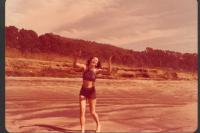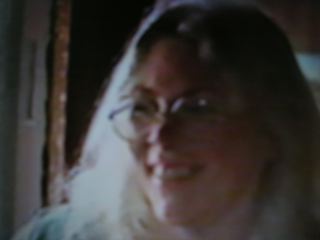Charlie Nye & The Reefs: Part I
There was a time when you’d mosey on over to the foggy Coastside and head north to Moss Beach and walk around the tidepools of the Fitzgerald Marine Reserve–and if you were the curious type you’d find a very unusual house at Nevada and Beach Streets– decorated with abalone seashells on the exterior that spelled out “Nye’s Reef’s II”.
This place with the abalone shells was an instant draw.
Knock on the door and you’d discover this is where Charlie Nye lived, an eccentric, loveable guy who opened up his home to visitors whenever he felt like it.
His father, also called Charlie Nye, had been the famous owner of a popular restaurant, featuring his special clam chowder recipe–but his son didn’t follow in his father’s footsteps. Usually wearing a black turtleneck, Charlie Nye, Jr. had one of those small refrigerators, a couple of feet tall, and if you were thirsty he’d offer you a soft drink. That’s as close as he got to the restaurant business.
Charlie Nye, Jr. inside “The Reefs II” in 1980 photo by June
photo by June
Charlie’s house was a charming one-of-a-kind– jam-packed with all kinds of old stuff including an antique piano which he played and overstuffed furniture and beach memorabilia and lots of dust .
It was a treat to spend an hour with Charlie.
He loved to chat and talk about his father who came to the Coastside after the Spanish-American War in 1898. “It was the one place he found where he didn’t suffer from remittent malaria,” Charlie told me.
His father settled in at Moss Beach and was introduced to the ambitious Harr Wagner, a San Francisco publisher and land developer who was trying to establish an artist’s colony in Montara. Wagner’s wife was Madge Morris, a published poet–and for the artist’s colony to succeed it was critical that the Ocean Shore Railroad do so, too.
But the timing of the building of the railroad was way off-track–the Ocean Shore Company couldn’t have had worse luck as the earth- shaking tremors of the catastrophic 1906 earthquake ripped up the work that had been done on Devil’s Slide and tossed expensive equipment and rails into the Pacific Ocean.
Not only were they way behind schedule, this was a financial disaster for the railroad, one that the Ocean Shore never recovered from. The railroad’s failure also threatened the success of a famous Moss Beach resort owned by Jurgen Wienke, also known as “the Mayor of Moss Beach”. (There is a street leading to the ocean named after him).
Guests arrived by horse and carriage at Wienke’s Hotel which was his sprawling home and gardens. His wife and daughter acted as hostesses to a bevy of famous guests including Stanford’s president. On the sandy beach below Wienke’s hotel, he constructed a small building with a deck–a seafood restaurant, a place where boats could be rented.
But once the locals surveyed the damage to the railroad at Devil’s Slide, the sound of misfortune filled the air.
Charlie Nye, Jr. told me, unlike the others, his father saw good luck in disguise.
Aaarrrghhh
Yesterday morning I left the house on time for an appointment–but then I got on Hwy 92:
But there was nothing I could do about it:
I thought I’d been stuck because of an accident but, no, it was the orange flag that made me 30 minutes late for an appointment:
Yeah, I’m complaining. Two weeks ago my boyfriend gets rear-ended on Hwy 1 and I learn that it’s very common these days to get rear-ended on Hwy 1 during morning commute–and then I get on Hwy 92, I’m on time, and — I get stuck in an endless line of traffic and I’m late, very late.
We might as well post insurance reps on the highway to settle damages–or maybe issue a disclaimer to anyone moving here along these lines: Yes, this is paradise–but you’ll probably face a line of cars on your way to work andyou might eeven get rear-ended.
This is getting to the point of ridiculousness. We’ve known about the problem as for years now more folks have been moving to the Coastside than there are roads to accommodate their vehicles, not to forget visitors from other places. You know, the tourists, the surfers, the walkers and bikers. The people who support our businesses.
More importantly, what happens if there is an earthquake?
1930’s County Map
Coastside Cheesecake
Once Upon A Time
Looking out on El Granada beach, circa 1930s, as painted by the locally famous artist Galen Wolf
The two-story building was an Ocean Shore-era “bathhouse” and, to the south, there’s what looks like a farmer’s barn. For years Galen lived at Frenchman’s Creek and every corner of the beautiful Coastside was his canvas.
Kirlian Photography
 This was the energy field, “the aura” around my fingers a quarter century ago. The aura was captured via Kirlian photography –which allegedly reveals the unique body’s spirit energy at the moment “the picture” is taken.
This was the energy field, “the aura” around my fingers a quarter century ago. The aura was captured via Kirlian photography –which allegedly reveals the unique body’s spirit energy at the moment “the picture” is taken.
Earthy photographer Michael Powers of Miramar –and of kyak and geodesic dome and and spiritual fame took the “picture ” using special Kirlian photography equipment 25 years ago.
When I first arrived on the Coastside, Michael Powers was a successful greeting card photographer. He often featured the natural beauty of Half Moon Bay in his trademark picture.
Here’s one Michael took of his former wife, Maria and their daughter, Marika, feeling merry in the lovely local flower fields.

Remembering Woodworking Craftsman Chuck Bodin
When I first got to the Coastside it wasn’t like it is today–it wasn’t bustling, there wasn’t construction going on everywhere, the roads were carless, especially Highway 92 (wheeeeee) and the hot waves hadn’t been discovered by the young men & women in their wetsuits.
Happy days. Woodworker Chuck Bodin plays on El Granada beach. 
Not much had happened to HMB since after WWII in the 1950s, and for me that was the Coastside’s charming appeal. Very few people lived on the ong and narrow marine terrace, bounded to the east by the coastal hills and mountains. The fickle fog that covered everything up on the Coastside could be seen from afar by people standing in the bright warm sun on the other side of the hill–better to stay home, they said, looking over the at the ocean.
Sure, there were farmers and folks lucky enough to have llived on the Coastside all their lives–but what I found was a bohemian atmosphere– and that’s what appealed to me. There was a small, close-knit community of carpenters and woodworkers. So if something terrible happened to a member of this community or among the fishermen the news spread fast.
MaryLou, Chuck’s wife, hams it up for the camera.
On or about March 24, 1975, Chuck Bodin, at 39, an older member of the craftsmen community, was killed in a car crash on Highway 92. He owned a big old truck, one of the biggest I’d seen around here but he need it for the projects he worked on and for wood he was moving around. Chuck also owned a red VW bug and that’ s what he was driving somewhere near the “House of Doors” on the day he was killed heading “over the hill”.
The minute the sad news broke, the El Granada community–where Chuck, his wife, MaryLou and daughter resided–rallied around the family. At the time Mary Day (Schlecht) was the “mother” figure and a dinner was announced at her home–an old white Victorian-style home built on an oversized lot.
Mary was in charge of everything–the town meetings were held there, birthdays, you name it. She was heavily involved with the “Voice of the Coast” newspaper and a dependable, active member of the tiny community.
The night we lost Chuck his friends and neighbors came together. His brother, Rudy, came, and I recall he played a significant role in Ken Kesey’s brilliant “One Flew Over the Cuckoo’s Nest”, either the play or the movie, perhaps as a director. The local dentist Fred and his wife, Cathy were there and other prominent carpenters like Michael Sharpe.
One of Chuck Bodin’s last projects was the construction of a pair of gorgeous doors for a beautiful Moss Beach home overlooking the Pacific Ocean. I’m going to share a photo of those with you.
I might add that Pete Douglas (Bach Dancing & Dynamite Society) often generously turned his place over to locals for memorials and other celebrations of life and death.
These magnificent doors leaning up against this unique Moss Beach house represent one of Chuck Bodin’s last projects–





 Galen Wolf, Coastside artist.
Galen Wolf, Coastside artist.

